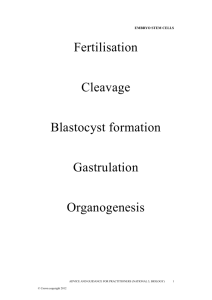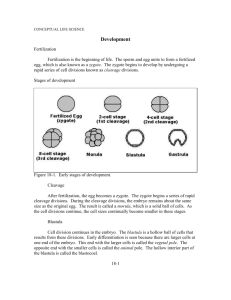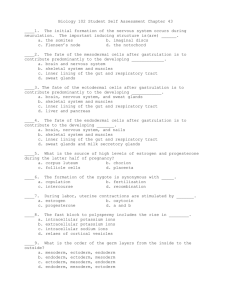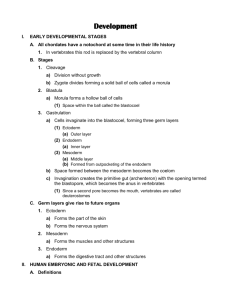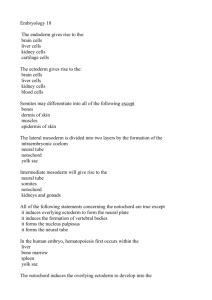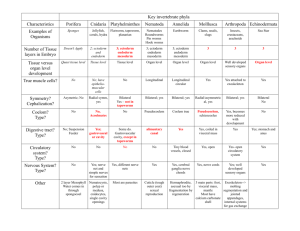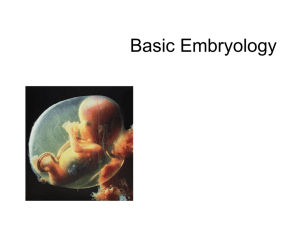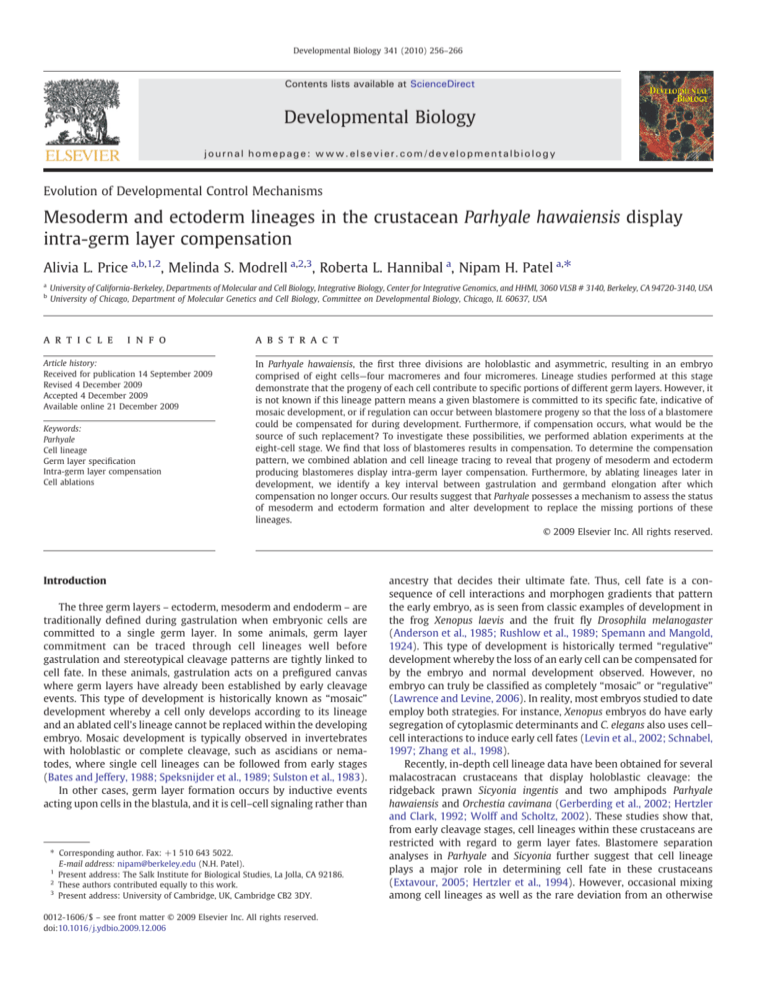
Developmental Biology 341 (2010) 256–266
Contents lists available at ScienceDirect
Developmental Biology
j o u r n a l h o m e p a g e : w w w. e l s e v i e r. c o m / d e v e l o p m e n t a l b i o l o g y
Evolution of Developmental Control Mechanisms
Mesoderm and ectoderm lineages in the crustacean Parhyale hawaiensis display
intra-germ layer compensation
Alivia L. Price a,b,1,2, Melinda S. Modrell a,2,3, Roberta L. Hannibal a, Nipam H. Patel a,⁎
a
b
University of California-Berkeley, Departments of Molecular and Cell Biology, Integrative Biology, Center for Integrative Genomics, and HHMI, 3060 VLSB # 3140, Berkeley, CA 94720-3140, USA
University of Chicago, Department of Molecular Genetics and Cell Biology, Committee on Developmental Biology, Chicago, IL 60637, USA
a r t i c l e
i n f o
Article history:
Received for publication 14 September 2009
Revised 4 December 2009
Accepted 4 December 2009
Available online 21 December 2009
Keywords:
Parhyale
Cell lineage
Germ layer specification
Intra-germ layer compensation
Cell ablations
a b s t r a c t
In Parhyale hawaiensis, the first three divisions are holoblastic and asymmetric, resulting in an embryo
comprised of eight cells—four macromeres and four micromeres. Lineage studies performed at this stage
demonstrate that the progeny of each cell contribute to specific portions of different germ layers. However, it
is not known if this lineage pattern means a given blastomere is committed to its specific fate, indicative of
mosaic development, or if regulation can occur between blastomere progeny so that the loss of a blastomere
could be compensated for during development. Furthermore, if compensation occurs, what would be the
source of such replacement? To investigate these possibilities, we performed ablation experiments at the
eight-cell stage. We find that loss of blastomeres results in compensation. To determine the compensation
pattern, we combined ablation and cell lineage tracing to reveal that progeny of mesoderm and ectoderm
producing blastomeres display intra-germ layer compensation. Furthermore, by ablating lineages later in
development, we identify a key interval between gastrulation and germband elongation after which
compensation no longer occurs. Our results suggest that Parhyale possesses a mechanism to assess the status
of mesoderm and ectoderm formation and alter development to replace the missing portions of these
lineages.
© 2009 Elsevier Inc. All rights reserved.
Introduction
The three germ layers – ectoderm, mesoderm and endoderm – are
traditionally defined during gastrulation when embryonic cells are
committed to a single germ layer. In some animals, germ layer
commitment can be traced through cell lineages well before
gastrulation and stereotypical cleavage patterns are tightly linked to
cell fate. In these animals, gastrulation acts on a prefigured canvas
where germ layers have already been established by early cleavage
events. This type of development is historically known as “mosaic”
development whereby a cell only develops according to its lineage
and an ablated cell's lineage cannot be replaced within the developing
embryo. Mosaic development is typically observed in invertebrates
with holoblastic or complete cleavage, such as ascidians or nematodes, where single cell lineages can be followed from early stages
(Bates and Jeffery, 1988; Speksnijder et al., 1989; Sulston et al., 1983).
In other cases, germ layer formation occurs by inductive events
acting upon cells in the blastula, and it is cell–cell signaling rather than
⁎ Corresponding author. Fax: +1 510 643 5022.
E-mail address: nipam@berkeley.edu (N.H. Patel).
1
Present address: The Salk Institute for Biological Studies, La Jolla, CA 92186.
2
These authors contributed equally to this work.
3
Present address: University of Cambridge, UK, Cambridge CB2 3DY.
0012-1606/$ – see front matter © 2009 Elsevier Inc. All rights reserved.
doi:10.1016/j.ydbio.2009.12.006
ancestry that decides their ultimate fate. Thus, cell fate is a consequence of cell interactions and morphogen gradients that pattern
the early embryo, as is seen from classic examples of development in
the frog Xenopus laevis and the fruit fly Drosophila melanogaster
(Anderson et al., 1985; Rushlow et al., 1989; Spemann and Mangold,
1924). This type of development is historically termed “regulative”
development whereby the loss of an early cell can be compensated for
by the embryo and normal development observed. However, no
embryo can truly be classified as completely “mosaic” or “regulative”
(Lawrence and Levine, 2006). In reality, most embryos studied to date
employ both strategies. For instance, Xenopus embryos do have early
segregation of cytoplasmic determinants and C. elegans also uses cell–
cell interactions to induce early cell fates (Levin et al., 2002; Schnabel,
1997; Zhang et al., 1998).
Recently, in-depth cell lineage data have been obtained for several
malacostracan crustaceans that display holoblastic cleavage: the
ridgeback prawn Sicyonia ingentis and two amphipods Parhyale
hawaiensis and Orchestia cavimana (Gerberding et al., 2002; Hertzler
and Clark, 1992; Wolff and Scholtz, 2002). These studies show that,
from early cleavage stages, cell lineages within these crustaceans are
restricted with regard to germ layer fates. Blastomere separation
analyses in Parhyale and Sicyonia further suggest that cell lineage
plays a major role in determining cell fate in these crustaceans
(Extavour, 2005; Hertzler et al., 1994). However, occasional mixing
among cell lineages as well as the rare deviation from an otherwise
A.L. Price et al. / Developmental Biology 341 (2010) 256–266
invariant cell lineage pattern shows that there is some capacity for
regulation among the cell lineages (Gerberding et al., 2002; Hertzler
et al., 1994). Thus, among crustaceans it is unclear whether early
lineage restriction to germ layers is indicative of mosaic development
or if regulation may play a role.
The first three cleavages in Parhyale occur in a very regular manner
and result in the formation of an eight-cell embryo with four
macromeres and four micromeres that give rise to highly stereotyped
lineages (Gerberding et al., 2002). As summarized in Fig. 1, in
Parhyale, the four macromere lineages will give rise to somatic
mesoderm of the head anterior to maxilla 2 (mx2) plus the visceral
mesoderm (Mav), right anterior ectoderm (Er), left anterior ectoderm
(El) and posterior ectoderm (Ep). The four micromeres lineages will
give rise to germline (g), right somatic trunk mesoderm posterior to
and including mx2 (mr), endoderm (en) and left somatic trunk
mesoderm posterior to and including mx2 (ml). These cell lineage
studies raise the question of how early during development these cells
are committed, if at all, to their subsequent germ layer fates and
whether cell–cell interactions play a role in determining these fates. It
is currently unknown to what extent maternal factors are unequally
distributed within the Parhyale egg and early embryo, but experiments in which blastomeres from the two-, four- and eight-cell stages
were separated suggest that there is a cytoplasmic determinant of the
germline that is differentially localized during early cleavages
(Extavour, 2005). Given the apparent restriction of cell fate and the
potential localization of determinants during early cleavages, we set
out to explore how mosaic the Parhyale embryo is and to what extent
regulation is occurring during embryogenesis.
A classic approach to determining if development is mosaic from
early stages is to ablate blastomeres and determine if the resulting
embryo is deficient for structures that would have arisen from the
ablated cells. Parhyale is a perfect candidate for such an approach
because the early embryo displays a stereotypical cleavage pattern
and cells can be easily identified at the eight-cell stage based on size
and orientation (Gerberding et al., 2002). In this study, we focus on six
of the eight blastomeres, ml, mr, Mav, El, Er and Ep, as these give rise
to the readily distinguishable mesoderm and ectoderm derivatives of
the embryo. The ablation of the remaining blastomeres, g and en, will
be discussed elsewhere. We first ablate individual blastomeres to
show that regulation does occur in Parhyale when progenitor cells are
eliminated. We go on to show that, while regulation does occur, the
257
embryo is mosaic in so far as blastomere progeny are only able to
participate in intra-germ layer compensation such that mesoderm
lineages will compensate for loss of mesoderm and ectoderm lineages
will compensate for loss of ectoderm. Then, using a combination of
later stage ablations and cell labeling experiments, we demonstrate
how and when regulation occurs among the mesoderm and ectoderm
lineages.
Materials and methods
Injection and photoablation
P. hawaiensis rearing and staging followed previously published
procedures (Browne et al., 2005). To follow lineages, specific
blastomeres were injected (Gerberding et al., 2002) with capped
mRNA (SP6 Ambion mMessageMachine kit) encoding a nuclear
localized version of DsRed (called DsRed-NLS; Price and Patel, 2008).
Photoablation of targeted cells was achieved by injection of
approximately 100 pl of 25 to 50 mg/ml fluorescein isothiocyanate
(FITC) covalently linked to dextran (250,000MW) (Sigma) into
individual blastomeres followed by exposure of the entire embryo
to the fluorescein excitation wavelength (λ = 488 nm) for 20 min
(Shankland, 1984). For ablations at the eight-cell stage, cells were
ablated using a Zeiss StemiSV11 Apo fluorescent dissecting scope. For
ablations at gastrulation or germband elongation, cells were ablated
on a Zeiss Axiophot under a Zeiss Plan-NeoFLUAR 10×/0.3 objective
set to the fluorescein filter. Cells that did not contain FITC were
unaffected by irradiation and cell death occurred only in cells
containing high levels of FITC. Cell death following irradiation was
confirmed by the cessation of cell division, which would have
normally occurred approximately 90 min after the division to the
eight-cell stage, and the later presence of cellular debris. This cellular
debris was either absorbed into the developing gut or was shunted to
the outside of the embryo where it remained as granular debris
between the eggshell and embryo. Embryos exhibiting injection
trauma were discarded. For the n = x/y values shown throughout the
results, y represent the number of embryos in which lineage injection
and ablation were successful and the embryos survived to the stage
required, and x represents the number of embryos that showed the
indicated pattern of compensation (or in some cases, lack of
compensation). For all our results, x = y reflecting that Parhyale
Fig. 1. Fate map of the eight-cell stage in Parhyale. Representation of early Parhyale development with blastomeres colored to indicate their lineage and eventual germ layer fate;
diagram shows orientation of the blastomeres and their progeny at the eight-cell stage (S4; 7.5 hpf), gastrulation (S8; 25 hpf) and germband elongation (S15; 80 hpf). The
blastomeres of the eight-cell stage are germ layer restricted and their progeny can be followed through development (Gerberding et al., 2002). View at S4 is dorsal with anterior up
and posterior down. View at S8 is lateral with anterior to the left, dorsal up. View at S15 is ventral with anterior up.
258
A.L. Price et al. / Developmental Biology 341 (2010) 256–266
embryos have a remarkably robust and precise pattern for compensation. Embryos that did not make it to the appropriate stage to be
assayed generally died relatively soon after injection due to either
immediate injection trauma or severe morphological damage.
Embryos were prepared for microscopy as previously described
(Price and Patel, 2008).
Antibody staining and in situ hybridization
Embryo fixation and in situ procedures were performed as
described in Rehm et al. (2009). Antibody staining was performed
according to Patel (1994). Primary antibody incubations were
overnight at 4 °C with rabbit anti-DsRed (Clontech) at 1:1000
dilution. Secondary antibody incubations were either at 2 h at room
temperature or overnight at 4 °C with HRP-conjugated goat antirabbit (Jackson ImmunoResearch) at 1:300–1:800 dilution. Following
histochemical reaction in DAB with nickel chloride, embryos were
counterstained with 1 μg/ml DAPI in 50% glycerol and transferred to
70% glycerol for clearing and mounting.
Results
Ablation of any mesoderm or ectoderm generating blastomere at the
eight-cell stage can result in a viable hatchling
Fate mapping as well as detailed descriptions of early cell
movements from the eight-cell stage in P. hawaiensis shows that cell
lineages are essentially invariant and give rise to the germ layers in a
stereotypical manner (Fig. 1; Gerberding et al., 2002; Price and Patel,
2008). If development were mosaic, then ablation of individual cells
would result in an incomplete embryo lacking structures derived from
the ablated lineage. On the other hand, if development of Parhyale is
regulative, the remaining lineages will compensate for this loss and
development of the embryo will be complete.
To test these possibilities, we first phototablated individual
blastomeres and then allowed embryos to develop to hatching. We
find that photoablation of any one of the six mesoderm or ectoderm
generating blastomeres, at the eight-cell stage, can result in a fully
formed and viable animal. In these animals, none of the ablated tissues
are missing demonstrating that the remaining blastomeres must be
able to compensate for this loss.
Compensation between mesoderm and ectoderm lineages is not
observed following ablation at the eight-cell stage
To determine which lineages are able to compensate for the ablation
of specific blastomeres, we combined ablation with lineage tracing
experiments to uncover patterns of compensation during the development of mesoderm and ectoderm-ablated embryos. At the third
cleavage, the ml and mr micromeres derive from an asymmetric
division in which their sibling macromeres become ectodermal
precursors (El and Er, respectively) (Gerberding et al., 2002). Therefore,
we first sought to determine whether this relationship was retained
such that ectoderm lineages might compensate for the loss of sibling
mesoderm lineages. To do this, we injected mRNA encoding nuclear
localized DsRed (DsRed-NLS) into one blastomere to act as a lineage
tracer allowing us to track the origin of any compensating cells and
ablated another blastomere as previously described.
We find that labeled El or Er lineages never give rise to
mesodermal derivatives when the sister mesoderm micromere was
ablated (n = 5/5; data not shown). Therefore, the E macromere
lineages do not compensate for ablated m micromere lineages. In the
reciprocal experiment, when an E macromere is ablated and the sister
m micromere labeled, we never observe the labeled mesodermal
lineage giving rise to ectodermal cells (n = 28/28; data not shown).
These results show that compensation is not occurring between
mesoderm and ectoderm sister blastomeres.
Ablation of a mesoderm blastomere – Mav, ml or mr – at the eight-cell
stage is compensated for by the nonablated mesodermal lineages
We then tested whether it was the other mesodermal lineages that
were able to compensate for the loss of a mesoderm blastomere.
Normally, the Mav blastomere gives rise to the visceral mesoderm
that surrounds the midgut anlagen as well as somatic head mesoderm
anterior to mx2 (Browne et al., 2005; Figs. 2A, B–B″), while the ml and
mr micromeres give rise to the mesoderm posterior to and including
mx2 on the left and right sides, respectively, via a stereotyped lineage
pattern that includes the asymmetric division of mesoteloblast cells
into mesoblasts which then divide and further differentiate into
segmental mesoderm (Gerberding et al. 2002; Price and Patel, 2008;
Figs. 2G, H–H″).
First we tested whether Mav, the only macromere that gives
rise to mesoderm, can compensate for loss of ml or mr lineages. In
the ml or mr ablated embryos, we find that the DsRed-injected
Mav lineage gave rise to labeled mesoteloblasts on the ablated
side of the elongating germband, replacing the ablated lineage
(n = 14/14; Figs. 2C, D–D″). When both ml and mr micromeres
are ablated at the eight-cell stage, the progeny of Mav is able to
compensate for the segmental mesoderm on both left and right
sides of the germband (n = 9/9; Figs. 2E, F–F″). These results show
that Mav is capable of producing mesoderm in segments posterior
to and including mx2 in ablated animals. Interestingly, in these
ablations, we never observe the progeny of ml compensating for mr
or vice versa.
We next tested whether ml and mr were able to compensate
for ablation of Mav. When we ablate Mav with concurrent labeling
of ml or mr, we find that ml and mr are able to compensate for
Mav loss (n = 14/14; Figs. 2I, J–J″). This indicates that the ml and
mr lineages can produce the full complement of visceral and
somatic mesoderm anterior to mx2. Moreover, in these ablations,
ml/mr progeny produce compensating mesoderm only on the left
or right sides, respectively, of the visceral mesoderm, implying a
spatial restriction in the pattern of compensation. This restriction is
overcome when Mav and either ml or mr are ablated. In these
cases, we observed that the remaining m micromere was able to
compensate for the visceral mesoderm on both the left and right
sides as well as the mesoderm in segments anterior to mx2 and
the mesoteloblasts on the ablated side (n = 7/7; Figs. 2K, L–L″).
These results show that the mesoderm blastomeres – Mav, ml and
mr – compose a mesoderm group (M) that is capable of intra-germ
layer compensation.
Fig. 2. Mesoderm compensation following ablation at the eight-cell stage. All embryos are ventral views of germband stage embryos except for (A, C, E, G, I, K) which are vegetal
views at the eight-cell stage. (A, C, E, G, I, K) Schematic at the eight-cell stage showing which cells have been ablated with FITC (black) or labeled with nuclear DsRed (red). Live darkfield image with fluorescent image overlay (B, D, F, H, J, L) or fluorescence only (B′, D′, F′, H′, J′, L′) to show orientation of cells in the context of the developing embryo. Embryos in this
panel range in stage from S12 to S15, thus display a varying number of mesoblast rows in the different images. (B″, D″, F″, H″, J″, L″) Schematic of germband stage embryos indicating
the observed lineage pattern (red) resulting after injection and/or ablation. (B, B′) The Mav lineage gives rise to visceral mesoderm observed as two bilateral spheres. (D, D′) When
mr is ablated, labeled Mav cells compensate for loss of the mesoteloblasts (MTB) and mesoblasts (MB) on the right side (blue arrowhead). (F, F′) When ml and mr are both ablated,
labeled Mav progeny compensate for MTB and MB (blue arrowheads) on both left and right sides. (H, H′) The ml lineage gives rise to the somatic mesoderm on the left side. (J, J′) In a
Mav ablation, labeled ml cells give rise to the visceral mesoderm (blue arrow) on the left side. (L, L′) In a Mav and mr ablated embryo, the only remaining mesoderm lineage, ml
(labeled), gives rise to the entire visceral mesoderm on both sides (blue arrows), as well as the somatic mesoderm on the right side (blue arrowhead). Scale bars: 100 μm.
A.L. Price et al. / Developmental Biology 341 (2010) 256–266
259
260
A.L. Price et al. / Developmental Biology 341 (2010) 256–266
mesoderm could easily be identified (Figs. 3C–C″) in triple-ablated
embryos, these derivatives were absent from the germband (n = 8/8;
Figs. 3D–D″). These results suggest that none of the remaining
blastomere derivatives can produce mesoderm and thus confirming
that the ml, mr and Mav blastomeres are the only cells that will give
rise to mesoderm from the eight-cell stage. Interestingly, ablation of
these three blastomeres did not interfere with the embryos ability to
gastrulate and form an elongating ectodermal germband suggesting
there is little, if any, instruction from the mesoderm to the ectoderm
during the initial phase of germband formation (stages 8–12). Later
roles could not be assessed as these embryos died by stage 13 (70 h
post fertilization [hpf]).
Ablation of an ectoderm blastomere – El, Er or Ep – at the eight-cell stage
is compensated for by the nonablated ectodermal lineages
Fig. 3. Lack of compensation following ablation of the three mesoderm blastomeres at
the eight-cell stage. (A) Schematic showing ablation of Mav, ml and mr. (B) Live image
of eight-cell embryo injected with FITC dextran (green) in ml, mr and Mav before
ablation. (C–D″) Ventral views of S15 DAPI-stained embryos. (C) Nonablated embryo at
germband elongation focusing on the ectoderm. Red arrows indicate the visceral
mesoderm, (C′) the underlying visceral and segmental mesoderm and (C″) confocal
stack of the area in C′ (box) clearly showing the rows of mesoteloblasts (⁎) and
mesoblasts (red arrowhead points to one of the rows of mesoblasts). (D) Triple
mesoderm-ablated embryo focusing on the ectoderm, (D′) the underlying plane where
mesoderm is usually found and (D″) confocal stack of area in D′ (box) showing the loss
of mesoteloblasts and mesoblasts in ablated embryos. Loss of the visceral mesoderm is
evident in D, D′. Scale bars: 100 μm, except in (C″, D″): 20 μm.
Ablation of the three mesoderm blastomeres – Mav, ml and mr – are not
compensated for by any other lineages
To further support our hypothesis of a mesoderm group, we
ablated all three mesoderm producing blastomeres (Mav, ml and mr)
at the eight-cell stage. When all three mesoderm blastomeres were
ablated at the eight-cell stage (Figs. 3A, B), there was a complete loss
of mesoderm. Compared to nonablated embryos in which mesodermal derivatives such as the mesoteloblasts, mesoblasts and visceral
Given the presence of the mesoderm group, we next wanted to see
if a similar relationship exists among the ectodermal lineages. Recall
that the ectoderm in Parhyale is generated from three specific
macromeres at the eight-cell stage: El, Er and Ep (Fig. 1). Each
ectodermal macromere gives rise to a spatially restricted clone of cells
in the left, right and posterior regions of the embryo, respectively
(Gerberding et al., 2002; Fig. 1). To determine if the remaining
ectodermal lineages compensate for the loss of an ectoderm
blastomere, we photoablated one ectoderm blastomere and labeled
a different ectoderm blastomere with the lineage tracer DsRed-NLS at
the eight-cell stage. Our results show that the loss of any ectoderm
blastomere is compensated for by the progeny of the remaining two
ectoderm blastomeres in a predictable way. Normally, the El and Er
blastomeres give rise to the left and right head ectoderm as well as
portions of the left and right thoracic ectoderm, respectively (Figs.
4A, A′). The extent to which El or Er clones comprise the thoracic
region varies between embryos with the remainder of the region
being comprised of cells from the Ep lineage (Figs. 4B, B′; Gerberding
et al., 2002). Labeling of El and ablation of Er or vice versa at the eightcell stage resulted in labeled cells throughout the head region anterior
to and including the anterior compartment of maxilla (mx1) of the
developing germband, but not in the region posterior to the anterior
compartment of mx1 of the ablated side (n = 7/7; Figs. 4C, C′). As the
region posterior to the anterior compartment of mx1 is normally
formed in the El or Er ablated embryos, we expected that the cells
compensating in this region might come from the lineage of the Ep
blastomere which normally generates the posterior thoracic and
abdominal ectoderm as well as the majority of the midline cells.
Indeed, ablation of either the Er or El blastomere results in an
extension of the labeled Ep lineage up to and including the posterior
compartment of mx1, which is normally occupied by the ablated
lineage (n = 8/8; Figs. 4D, D′). Given this result, we then tested
whether the reciprocal ablation would extend the lineages of El and Er
posteriorly when Ep was ablated. We find that ablation of Ep and
labeling of El or Er results in labeled progeny that occupy the entire
left or right side of the germband, respectively, extending into the
regions that are normally comprised of Ep lineage cells (n = 5/5; Figs.
4E, E′). Strikingly, the compensating cells from El or Er do not cross the
midline. Further, when a single ectoderm blastomere is ablated and
the remaining two are labeled, we find the entire ectoderm of the
resulting embryo is labeled confirming that the remaining two
ectoderm blastomeres fully compensate for the loss of the third
(n = 2/2; Figs. 4F, F′). Embryos in which two ectoderm blastomeres
are ablated do not survive to even an early germband stage; therefore,
we cannot test whether the progeny of a single ectoderm blastomere
is able to fully compensate for the loss of the other two ectoderm
blastomeres, as is observed with the mesoderm.
In order to further investigate the patterns of the intra-germ layer
compensation observed, we analyzed the localization of the lineage
tracer in fixed specimens, rather than in live embryos, using an
A.L. Price et al. / Developmental Biology 341 (2010) 256–266
261
Fig. 4. Ectoderm compensation following ablation at the eight-cell stage. (A–F) Schematics of ablation (S4) and pattern of compensation (S15). Ablated blastomeres are in black;
DsRed labeled lineages are in red. (A′–F′) Live fluorescent images of DsRed labeled and ablated embryos at germband elongation stages (S12–S15). Ventral views. Blue arrow
indicates region of compensation. (A, A′) Labeling shows that the left ectoderm lineage maintains a boundary at the midline. The larger labeled nuclei are vitellophages underlying
the germband that are also generated from the E blastomeres. (B, B′) Labeling shows the Ep lineage gives rise to the posterior ectoderm and midline. (C, C′) In an Er ablated and El
labeled embryo, El compensates for the right ectoderm in the region anterior to and including the anterior compartment of mx1 (arrow). (D, D′) In Er ablated embryos, labeled Ep
cells compensate for the ablated lineage on the right side of the germband, posterior to the anterior compartment of mx1 (arrow). (E, E′) In an Ep ablated and El labeled embryo, El
compensates in the left posterior ectoderm (arrow). (F, F′) In Er ablated embryos where both El and Ep are labeled, the entire germband is labeled, with compensating cells
presumably derived from El in the region anterior to and including the anterior compartment of mx1 (top arrow) and those from Ep in the region posterior to the anterior
compartment of mx1 (bottom arrow), respectively. Scale bars: 100 μm.
antibody to DsRed at older stages of development (Fig. 5). By stage 19
(96 hpf), the germband is completely segmented and the appendages
are becoming well defined and identifiable (Browne et al., 2005).
Control embryos labeling the lineages of Er (Figs. 5A, A′), Ep (Figs.
5C, C′) and El (Figs. 5E, E′) show the typical lineage pattern of each
of these blastomeres. Interestingly, following ablation, the pattern of
Er and El lineage compensation appeared limited to the head region
anterior to and including the anterior compartment of mx1 (Figs.
5B, B′), while the extent of Ep compensation was restricted to the
region posterior to the anterior compartment of mx1 (Figs. 5D, D′),
thereby supporting the parasegmental boundary of compensation
seen in younger embryos (Figs. 4C, C′ and Figs. 4D, D′). In the case of
compensation for posterior ectoderm normally made by Ep, a strict
adherence to the left–right boundary was maintained, so that El
compensated for the left posterior ectoderm (Figs. 5F, F′) and Er
compensated for the right posterior ectoderm (data not shown). The
cells that make up the midline were composed to varying extents of
both the left and right ectoderm lineages in these ablated embryos.
These results were intriguing because lineage studies of the ectoderm
blastomeres at the 16-cell stage in Parhyale reveal a similar finding—
that there is a parasegmental boundary between the anterior and
posterior compartments of mx1 that segregates the ectoderm derived
from El or Er into anterior and posterior regions (Figs. 5G–H′). In
addition, our lineage studies show that the progeny from the daughter
cells that result from division of Ep, Ep-l and Ep-r are segregated on the
left and right sides of the germband, respectively, with the midline
cells arising from either Ep-l or Ep-r or from both clones (Figs. 5I, I′).
These anterior–posterior and right–left boundaries correspond to the
patterns of compensation and boundaries we observe among the
ectodermal lineages in ablated embryos.
These results show that the El, Er and Ep blastomeres constitute an
ectoderm group (E) capable of intra-germ layer compensation. In
addition, we also find stereotypical spatial restrictions among these
ectoderm lineages. Although we find it unlikely, we cannot confirm
that in the complete absence of the ectoderm other lineages may be
able to compensate because embryos in which all three ectoderm
blastomeres are ablated do not survive. Taken together, these results
suggest that at the eight-cell stage a complete separation of ectoderm
and mesoderm fate occurs and cell contribution to germ layers is
already restricted.
Intra-germ layer compensation can occur as late as gastrulation
Having established that there are mesoderm and ectoderm groups
that exist at the eight-cell stage, we wanted to know how late into
development compensation could occur. An advantage of the
photoablation technique is that it allows us to successfully ablate
these cells at different developmental stages. By injecting blastomeres
at the eight-cell stage with FITC and performing ablations at later time
points in development, we were able to determine the degree to
which the nonablated lineages were able to compensate at various
stages of development. Using this approach, we first ablated
blastomere progeny during gastrulation stage 8 (20–24 hpf) in
order to determine if compensation could still occur following
ablation at this stage.
At gastrulation, each ml and mr clone consists of about six cells.
Following photoablation, these cells cease division and by 48 h post
ablation, their debris is no longer visible in the embryo. In gastrulation
stage ml or mr lineage-ablated embryos, we observe compensation of
mesoteloblast development by the progeny of Mav, but not by the
262
A.L. Price et al. / Developmental Biology 341 (2010) 256–266
Fig. 5. Pattern of compensation in ectoderm-ablated embryos. Ventral views. Anterior is up. Pattern of compensation in ectoderm-ablated embryos: (A–I) Bright-field images of S19/
20 anti-DsRed-stained embryos. (A′–I′) False color overlay of anti-DsRed staining on embryos counterstained with DAPI. (A, A′) In a control Er labeled embryo, labeled cells are
primarily restricted to the right side of the germband. Notice some mixing in the head region. (B, B′) In an El ablated and Er labeled embryo, the Er lineage compensates for the loss of
El in the region anterior to and including the anterior compartment of mx1 (black bar). The posterior most segments are missing due to dissection misfortune. (C, C′) In a control Ep
labeled embryo, cells are restricted to the posterior ectoderm and midline cells. (D, D′) In an Er ablated and Ep labeled embryo, the posterior ectoderm compensates for the loss of El
in the region posterior to the anterior compartment of mx1. (E, E′) In a control El labeled embryo, labeled cells are restricted to the left side of the germband. (F, F′) In an Ep ablated
and El labeled embryo, the El lineage compensates for the loss of Ep in the posterior germband on the left side. Lineage pattern from the 16-cell stage ectodermal cells: (G, G′) In a
control Er-anterior (Er-a) labeled embryo, labeled cells extend to and include the anterior compartment of mx1. (H, H′) In a control El-posterior (El-p) labeled embryo, labeled cells
occupy the region posterior to the anterior compartment of mx1. (I, I′) In an Ep-left (Ep-l) labeled embryo, labeled cells are restricted to the left side of the midline. The lineages of the
ectodermal blastomeres from the 16-cell stage reflect the boundaries observed between the anterior and posterior compartments of mx1 and at the level of the thoracic midline in
ablated embryos. Scale bar: 100 μm.
remaining m micromere—identical to the situation seen in ablations
at the eight-cell stage (n = 10/10; see Figs. 2D–D″).
At gastrulation, the Mav lineage normally consists of approximately ten cells. Following ablation of the Mav lineage at gastrulation,
the progeny of ml and mr are able to compensate for the ablated
lineage—again identical to the situation seen for ablations at the eightcell stage (n = 14/14; see Figs. 2J–J″).
Within the E lineages, the same pattern of compensation is
observed in gastrulation stage ablated embryos as was seen in the
eight-cell-stage ablated embryos (Supplementary Fig. 1). Each E clone
(El, Er or Ep) consists of approximately 27–31 cells at gastrulation.
These ectoderm clones are organizing into a germ disc and are
already spatially organized into left, right and posterior regions
(Browne et al., 2005). Ablation of ectoderm clones at gastrulation
results in embryos that are severely developmentally delayed,
particularly on the ablated side, and as a consequence develop
asymmetrically. Briefly, ablation of either Er or El progeny are
compensated for by the progeny of El or Er, respectively, in the region
anterior to and including the anterior compartment of mx1, while the
progeny of Ep compensates for the loss of cells in the region posterior
to the anterior compartment of mx1 (n = 8/8); ablated Ep progeny
are compensated for by the El and Er lineages (n = 4/4) in the
posterior thoracic and abdominal region. Moreover, in the case of the
gastrulation stage ectoderm ablations, the pattern of compensation
continues to be spatially restricted to observe the left–right boundary
in the thoracic region as well as a parasegmental boundary between
the anterior and posterior compartment of mx1, as observed in
ablations performed at the eight-cell stage. These results show that
compensation among germ layer groups occurs as late as gastrulation
in a predictable manner.
Intra-germ layer compensation does not occur at germband stages
We next wanted to determine if there was a time in development
when compensation in the mesoderm or ectoderm lineages did not
occur. Using the same technique for ablations at gastrulation, we
A.L. Price et al. / Developmental Biology 341 (2010) 256–266
ablated blastomere progeny at the beginning of germband elongation
at stage 10/11 (56–60 hpf).
ml or mr lineage ablations performed just after formation of the
mesoteloblasts at germband elongation stage 10/11 (56–60 hpf;
Figs. 6A, B) resulted in no compensation for the ablated lineage
(n = 23/23). The Parhyale ortholog of myocyte enhancing factor 2
(Ph-mef2), a marker of differentiated mesoderm (Price and Patel,
2008), was completely absent on the ablated side (Figs. 6C, C′)
compared to the nonablated side and control embryo (Figs. 6D, D′),
demonstrating the loss of body musculature. Although these animals
were able to develop to late germband stage 24 (155 hpf), they
never hatched.
When Mav progeny were ablated at stage 10/11 (Figs. 6E, F), they
were not compensated for by the progeny of ml and mr, resulting in a
loss of the visceral mesoderm (n = 6/6). These embryos often
263
continued to develop; some developing as late as stage 26
(180 hpf). However, the midgut and digestive cecae clearly did not
form in ablated embryos (Figs. 6G, H) compared to nonablated
embryos (Figs. 6I, J). Based on these observations, compensation of
ablated mesodermal lineages does not occur following ablation at
germband stages.
Ablation of the ectoderm lineages derived from El or Er (n = 17/
17; Figs. 7A, B) or Ep (n = 9/9; Figs. 7D, E) at the germband
elongation stage 10/11 results in a permanent loss of that tissue,
suggesting that at this stage, the other ectoderm cells are not able to
compensate. Typically these embryos are severely affected and die
during germband elongation. Occasionally, some embryos reach
stages 21–23 (120–144 hpf), but these embryos lack the segments
and appendages from the ablated region (Figs. 7C, F) compared to
the nonablated side or nonablated embryos (Fig. 7G). The severity of
Fig. 6. Ablation of mesoteloblasts and visceral mesoderm at germband stage. (A, E) Live image and (B, F) schematic of S10 embryo at time of ablation of mr or Mav lineage (green
cells). (C, D) Bright-field image of Ph-mef-2 in situ in mr ablated (C) and nonablated (D) embryos at S22. (C′, D′) Corresponding false color overlay with DAPI. (A–F) Ventral views.
(G–J) Bright-field images showing development of the midgut or digestive cecae in Mav lineage-ablated (G, H) and control (I, J) embryos at S26. Anterior is to the left. (G, I) Lateral
views. (H, J) Dorsal views. (A, B) The four mesoteloblasts which gives rise to the segmental mesoderm have just formed at S10. (C) Ablation of mr progeny at S10 results in the loss of
segmental mesoderm as shown by the loss of expression of a muscle determination marker, Ph-mef2 on the ablated side. (D) A nonablated embryo stained for Ph-mef2. (E, F) At S10,
Mav progeny are present at the level of the forming midgut anlage as two circular masses of cells. (G, H) Ablation of Mav at germband stages results in embryos lacking a midgut or
digestive cecae. (I, J) Nonablated embryo with the midgut and bilateral cecae formed (asterisks). Scale bars: 100 μm.
264
A.L. Price et al. / Developmental Biology 341 (2010) 256–266
Fig. 7. Ablation of the ectoderm lineages at germband stage. Ventral views. (A, D) Fluorescent live images of S11 germband staged embryos at the time of ablation (green = FITC).
(B, E) Schematic of panels A and D, respectively. DAPI images of (C, F) S21 ablated and (G) nonablated embryos. (C) In an Er-germband ablated embryo there is a loss of anterior
right segments and limbs. The severity of loss varies between embryos based on the size of the ectodermal clone at time of ablation. In this case, this embryo has lost six anterior
segments on the right side (lost area represented by red outline). (F) Ep-germband ablated embryo. Ablation of the posterior ectoderm results in a complete loss of posterior
segments on both right and left sides (lost area represented by the red outline). (G) Control embryo. Scale bars: 100 μm.
the defects depends on the size of the clone at the time of ablation,
which varies greatly among embryos.
These results show that by the beginning of germband elongation,
compensation for the loss of ectoderm or mesoderm lineages no
longer occurs suggesting that, between the beginning of gastrulation
and the beginning of germband elongation in Parhyale, portions of the
germ layers have become committed.
Discussion
Mesoderm and ectoderm groups in Parhyale at the eight-cell stage
Due to its invariant cell lineage and ease to maintain and
manipulate in the laboratory, P. hawaiensis presents itself as an
attractive organism in which to explore the molecular mechanisms
behind early specification of germ layers and axes. Here, our results
demonstrate that, although early lineages are restricted, the early
development of the Parhyale embryo is also highly regulative. We
show that ablation of a mesoderm or ectoderm generating
blastomere at the eight-cell stage or its progeny at gastrulation
can be compensated for by cells of other lineages in a stereotypical
pattern.
In Parhyale, regulation of ablated lineages does not occur by intergerm layer compensation, but rather is restricted to specific germ
layer groups established at the third division. Our labeling and
ablation experiments show intra-germ layer compensation, such that
mesodermal cells can only compensate for loss of other mesodermal
cells while ectodermal cells can only compensate for loss of other
ectodermal cells. This demonstrates that at the eight-cell stage in
Parhyale, at least two germ layer groups are established: the
mesoderm group (Mav, ml and mr or M) and the ectoderm group
(El, Er and Ep or E). Our results suggest that these groups are not
present until the eight-cell stage and, indeed, in cell separation studies
it has been reported that each blastomere isolated at the two-cell
stage will continue to divide asymmetrically and can develop at least
to gastrulation and form multiple cell layers in Parhyale (Extavour,
2005). Thus, it is not until the third cleavage that the germ layer
potential of blastomeres becomes set. Equivalence groups are groups
of cells that will eventually contribute to different derivatives, but at
an earlier point in development, all have the same developmental
potential. Only after subsequent inductive events do they reach their
final state of differentiation (Kimble, 1981). It is possible that the germ
layer groups seen in Parhyale may constitute equivalence groups as
seen in C. elegans and ctenophores (Kimble, 1981; Henry and
Martindale, 2004). Further studies uncovering the molecular mechan-
isms allowing for proper compensation among these different cell
lineages will shed more light on this distinction.
The observed intra-germ layer compensation of cells suggests that
the embryo possesses mechanisms to assess the status of germ layers
and can respond to replace missing tissue or cell types. As may be
expected, the regulative ability of both groups diminishes as
development proceeds. This decrease in regulative ability culminates
in the interval between gastrulation and germband elongation where
the embryo loses the ability to replace ablated cells. Clearly, much of
the commitment of cells to their final fate has occurred by this time.
The ability of embryos to regulate until gastrulation suggests that
there must be cell–cell communication within the M and E groups that
can lead to changes in cell behavior. Also, the developmental lag in
compensating regions suggests that developmental patterning of
these regions is slowed, perhaps waiting for completion of a
developmental checkpoint. In compensated embryos, one can assume
that cell proliferation will need to be locally increased to replace
missing cells, however the selection of cells that are to proliferate may
be a critical step. The path along which the two germ layers normally
develop may provide insight into different mechanisms that could be
more important for compensation. For example, within the mesoderm
group, the compensated cells are divided into two distinct cell fates:
the visceral mesoderm or the segmental mesoderm. The critical
“checkpoint” for mesoderm compensation may be regulated primarily
by cell fate specific cues. On the other hand, the ectoderm behaves as
an epithelial sheet. Perhaps, the compensation of cells from an ablated
ectoderm blastomere is primarily driven by physical cues that drive
local proliferation to fill in the gap left by the ablated lineage. It will be
of great interest to understand the molecular signals behind these
checkpoints and how they fit into the germband elongation program
generally.
Presence and significance of the boundary between the anterior and
posterior compartments of maxillary 1 in the ectoderm and
somatic mesoderm
The ectoderm of the Parhyale germband can be subdivided into
two main regions that have different properties: the nonordered cells
of the head anterior to and including the anterior compartment of the
first maxillary segment (mx1) and the highly ordered cells posterior
to the anterior compartment of mx1 that are derived from rows of
cells called parasegment precursor cell rows (PSPR) which undergo
stereotypical divisions (Browne et al., 2005). These two distinct
regions can be observed starting very early in development, before
molecular markers of segmentation, such as Engrailed, are expressed
A.L. Price et al. / Developmental Biology 341 (2010) 256–266
(Browne et al., 2005). Indeed, lineage studies performed a the 16-cell
stage both here and in the amphipod O. cavimana, show that the
daughter cells of the macromeres El and Er will give rise to an anterior
and posterior region with the boundary of these clones dividing the
mx1 segment (i.e., a parasegment boundary), suggesting that this
boundary may be set up very early in development (Wolff and
Scholtz, 2002). Excitingly, our ablation experiments show that cells
compensating for the loss of either El or Er also do not appear to cross
this particular parasegmental boundary. While this result could be
explained by the rate of cell division and embryonic architecture
limiting the regions in which compensation may occur, the 16-cell
lineage studies and the striking difference between the two groups of
cells suggests that the regulative capacity of ectodermal blastomeres
at the 16-cell stage may not be equal (Browne et al., 2005; Wolff and
Scholtz, 2002). Either an inductive event or a differentially distributed
cytoplasmic determinant might define anteroposterior potential of
these blastomeres at this stage. Indeed, more evidence for these
possibilities is provided by ablation experiments at gastrulation stages
where the same parasegmental boundary of compensation from the
eight-cell stage is retained. However, future ablation experiments
coupled with a molecular characterization of compensation will
elucidate whether these boundaries are functional or coincident. It
will be of great interest to see what genes are expressed from the
eight-cell stage through the establishment of this boundary and if
their knockdown or overexpression cause changes in ectoderm
germband growth or identity.
Similar to the ectoderm, the somatic mesoderm can be subdivided into two main regions that have different properties:
nonordered cells anterior to mx2 that are not derived from
mesoteloblast divisions and the highly ordered cells posterior to
and including mx2 that are derived from the divisions of the
mesoteloblasts (Browne et al., 2005; Price and Patel, 2008).
Interestingly, the mesodermal cells derived from the mesoteloblasts
in mx2 are underneath the anterior compartment of mx2, which is in
the same parasegment as the posterior compartment of mx1 (i.e.:
the boundary between the two types of ectoderm and mesoderm is
the same for both tissues). It will be of great interest to see if the
same mechanism sets up this boundary in both the ectoderm and the
mesoderm.
Germ layer specification by induction or localization of determinants
The establishment of these germ layer groups so early in
development, even before the establishment of multiple layers of
cells is striking and indicates that the earliest cleavages may be highly
polarized. It is unclear what mechanisms are involved in these
polarized cell divisions, for example, whether maternal determinants
are placed asymmetrically in the egg as in Drosophila (Anderson and
Nusslein-Volhard, 1984; St Johnston and Nusslein-Volhard, 1992) or
whether some impetus from the sperm entry point is responsible for
establishing this polarity as in nematodes and ascidians (Bates and
Jeffery, 1988; Goldstein and Hird, 1996; Jeffery, 1982).
There is evidence that supports a combination of mechanisms in
Parhyale. First, there are visible asymmetries at the one-cell stage
that are associated with later polarity. Polar bodies, which in other
organisms are formed just following activation of the egg by sperm,
are clearly associated with the initial cleavage plane and the
subsequent development of the ectodermal blastomeres or “animal”
hemisphere (Browne et al., 2005). Second, maternally loaded factors
may also be important in Parhyale. On the “vegetal” side of the onecell embryo, opposite to the polar bodies, is a small island of
cytoplasm that marks the pole where micromeres will develop.
Indeed, at the eight-cell stage, the cytoplasm of the g micromere
(which gives rise to germline) of Parhyale clearly looks different from
the other cells (Gerberding et al., 2002). Furthermore, blastomere
isolations showed that the localization of a germline marker is
265
restricted to the lineage leading to the g blastomere (Extavour, 2005).
It is therefore likely that early cell asymmetries and localized maternal
factors play a role in specifying the mesoderm and ectoderm lineages.
Our experiments in Parhyale show that, although the restrictions
of early cell lineages would suggest mosaicism, the intra-germ layer
compensation observed demonstrates that regulation also occurs.
This supports the view that during metazoan development a
combination of early determinants and induction are more commonly
used and that more often, sequential periods of cell autonomy
followed by cell–cell interactions in a spatial and temporal context are
important for specification. In order to further our understanding of
the process of cell fate specification and germ layer compensation in
Parhyale, the molecular events leading to the establishment of the
germ layer groups and the subsequent signaling events occurring
within germ layers need to be uncovered.
Acknowledgments
We would like to thank all the members of the Patel lab for helpful
discussions. We especially give thanks to Meredith Protas, Paul Liu,
Cristina Grande, Henrique Marques-Souza, Crystal Chaw and E. Jay
Rehm as well as Dede Lyons and David Buckley for their valuable
feedback on this manuscript. NHP is an Investigator of the Howard
Hughes Medical Institute.
Appendix A. Supplementary data
Supplementary data associated with this article can be found, in
the online version, at doi:10.1016/j.ydbio.2009.12.006.
References
Anderson, K.V., Nusslein-Volhard, C., 1984. Information for the dorsal–ventral
pattern of the Drosophila embryo is stored as maternal mRNA. Nature 311,
223–227.
Anderson, K.V., Jurgens, G., Nüsslein-Volhard, C., 1985. Establishment of dorsal–ventral
polarity in the Drosophila embryo: genetic studies on the role of the Toll gene
product. Cell 42, 779–789.
Bates, W.R., Jeffery, W.R., 1988. Polarization of ooplasmic segregation and dorsal–
ventral axis determination in ascidian embryos. Dev. Biol. 130, 98–107.
Browne, W.E., Price, A.L., Gerberding, M., Patel, N.H., 2005. Stages of embryonic
development in the amphipod crustacean, Parhyale hawaiensis. Genesis 42,
124–149.
Extavour, C.G., 2005. The fate of isolated blastomeres with respect to germ cell
formation in the amphipod crustacean Parhyale hawaiensis. Dev. Biol. 277,
387–402.
Gerberding, M., Browne, W.E., Patel, N.H., 2002. Cell lineage analysis of the amphipod
crustacean Parhyale hawaiensis reveals an early restriction of cell fates. Development
129, 5789–5801.
Goldstein, B., Hird, S.N., 1996. Specification of the anteroposterior axis in Caenorhabditis
elegans. Development 122, 1467–1474.
Henry, J.Q., Martindale, M.Q., 2004. Inductive interactions and embryonic equivalence
groups in a basal metazoan, the ctenophore Mnemiopsis leidyi. Evol. Dev. 6,
17–24.
Hertzler, P.L., Clark Jr., W.H., 1992. Cleavage and gastrulation in the shrimp Sicyonia
ingentis: invagination is accompanied by oriented cell division. Development 116,
127–140.
Hertzler, P.L., Wang, S.W., Clark Jr., W.H., 1994. Mesendoderm cell and archenteron
formation in isolated blastomeres from the shrimp Sicyonia ingentis. Dev. Biol. 164,
333–344.
Jeffery, W.R., 1982. Calcium ionophore polarizes ooplasmic segregation in ascidian eggs.
Science 216, 545–547.
Kimble, J., 1981. Alterations in cell lineage following laser ablation of cells in the somatic
gonad of Caenorhabditis elegans. Dev. Biol. 87, 286–300.
Lawrence, P.A., Levine, M., 2006. Mosaic and regulative development: two faces of one
coin. Curr Biol. 16, R236–239.
Levin, M., Thorlin, T., Robinson, K.R., Nogi, T., Mercola, M., 2002. Asymmetries in H+/K+ATPase and cell membrane potentials comprise a very early step in left–right
patterning. Cell 111, 77–89.
Patel, N.H., 1994. Imaging neuronal subsets and other cell types in whole-mount
Drosophila embryos and larvae using antibody probes. Methods Cell Biol. 44,
445–487.
Price, A.L., Patel, N.H., 2008. Investigating divergent mechanisms of mesoderm
development in arthropods: the expression of Ph-twist and Ph-mef2 in Parhyale
hawaiensis. J. Exp. Zool., B Mol. Dev. Evol. 310, 24–40.
Rehm, E.J., Hannibal, R.L., Chaw, R.C., Vargas-Vila, M.A., Patel, N.H., 2009. The crustacean
266
A.L. Price et al. / Developmental Biology 341 (2010) 256–266
Parhyale hawaiensis: a new model for arthropod development. In: Crotty, D.A.,
Gann, A. (Eds.), Emerging Model Organisms: A Laboratory Manual. Cold Spring
Harbor Laboratory Press, New York, pp. 373–404.
Rushlow, C.A., Han, K., Manley, J.L., Levine, M., 1989. The graded distribution of the
dorsal morphogen is initiated by selective nuclear transport in Drosophila. Cell 59,
1165–1177.
Schnabel, R., 1997. Why does a nematode have an invariant cell lineage? Semin. Cell
Dev. Biol. 8, 341–349.
Shankland, M., 1984. Positional determination of supernumerary blast cell death in the
leech embryo. Nature 307, 541–543.
Speksnijder, J.E., Jaffe, L.F., Sardet, C., 1989. Polarity of sperm entry in the ascidian egg.
Dev. Biol. 133, 180–184.
Spemann, H., Mangold, H., 1924. Uber Induktion von Embryonalanlagen durch
Implantation artfremder Organisatoren. Arch. Mikrosk. Anat. Entwickl.mech. 100,
599–638.
St Johnston, D., Nusslein-Volhard, C., 1992. The origin of pattern and polarity in the
Drosophila embryo. Cell 68, 201–219.
Sulston, J.E., Schierenberg, E., White, J.G., Thomson, J.N., 1983. The embryonic cell
lineage of the nematode Caenorhabditis elegans. Dev. Biol. 100, 64–119.
Wolff, C., Scholtz, G., 2002. Cell lineage, axis formation, and the origin of germ layers in
the amphipod crustacean Orchestia cavimana. Dev. Biol. 250, 44–58.
Zhang, J., Houston, D.W., King, M.L., Payne, C., Wylie, C., Heasman, J., 1998. The role of
maternal VegT in establishing the primary germ layers in Xenopus embryos. Cell 94,
515–524.

